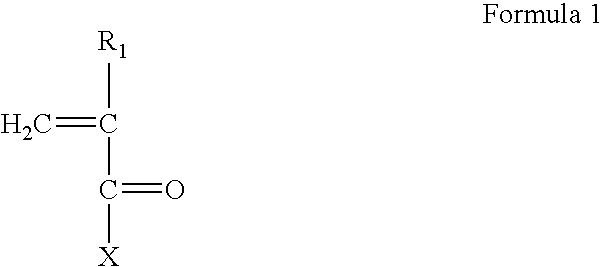Method of forming a patterned film of surface-modified carbon nanotubes
a technology of carbon nanotubes and patterned films, which is applied in the field of forming patterned films of carbon nanotubes, can solve the problem of not being able to achieve the effect of advantageous methods
- Summary
- Abstract
- Description
- Claims
- Application Information
AI Technical Summary
Problems solved by technology
Method used
Image
Examples
production example 1
Purification of Carbon Nanotubes
[0036]In a 500 ml flask equipped with a reflux tube, 100 mg of carbon nanotube (ILJIN CNT AP-Grade, Iljin Nanotech Co., Ltd., Korea) was refluxed with 50 ml of distilled water at 100° C. for 12 hrs and then filtered. The carbon nanotubes recovered from the filtration were dried at 60° C. for 12 hrs and washed with toluene so as to remove residual fullerene. Then, the remaining soot was collected and heated in a furnace at a temperature of about 470° C. for 20 minutes, followed by washing with plenty of 6M HCl solution to afford pure carbon nanotubes without metallic impurities.
production example 2
Surface Modification of the Carbon Nanotubes with Carboxyl Groups (Carboxylation)
[0037]In a sonicator filled with a mixed acid solution of nitric acid:sulfuric acid=7:3 (v / v), the pure carbon nanotubes obtained from the Production Example 1 were refluxed for 24 hrs. After being recovered from the filtration through a 0.2 μm polycarbonate filter, the carbon nanotubes were refluxed again in nitric acid at 90° C. for 45 hrs. Subsequently, the slurry was centrifuged at 12,000 rpm and the resulting supernatant was filtered through a 0.1 μm polycarbonate filter. Carbon nanotubes recovered from the filtration were dried at 60° C. for 12 hrs and dispersed in DMF, followed by filtration through a 0.1 μm polycarbonate filter for size sorting.
production example 3
Modification of the Surfaces of the Carbon Nanotubes with Double Bond-Containing Functional Group (1)
[0038]0.03 g of the carboxylated carbon nanotube obtained from the Production Example 2 was added to 20 ml of DMF and homogeneously dispersed by ultrasonification for 1 hr. To the dispersion was added a solution of 10 ml of TEA and 20 ml of DMF and the resulting dispersion was stirred for 1 hr. After the dispersion being placed in an ice-bath for cooling reaction-heat, 5 ml of acryloyl chloride mixed with 100 ml of DMF was slowly added to the dispersion drop by drop over 2 hrs with stirring and the mixture was allowed to react at room temperature for 24 hrs. At the completion of the reaction, the reaction mixture was added to 300 ml of distilled water and the resulting solids were recovered by filtration through a 0.2 μm polycarbonate filter. The solids were repeatedly washed with water and diethyl ether, 3 times respectively, so as to wash off unreacted acryloyl chloride. The washed...
PUM
 Login to View More
Login to View More Abstract
Description
Claims
Application Information
 Login to View More
Login to View More - R&D
- Intellectual Property
- Life Sciences
- Materials
- Tech Scout
- Unparalleled Data Quality
- Higher Quality Content
- 60% Fewer Hallucinations
Browse by: Latest US Patents, China's latest patents, Technical Efficacy Thesaurus, Application Domain, Technology Topic, Popular Technical Reports.
© 2025 PatSnap. All rights reserved.Legal|Privacy policy|Modern Slavery Act Transparency Statement|Sitemap|About US| Contact US: help@patsnap.com



